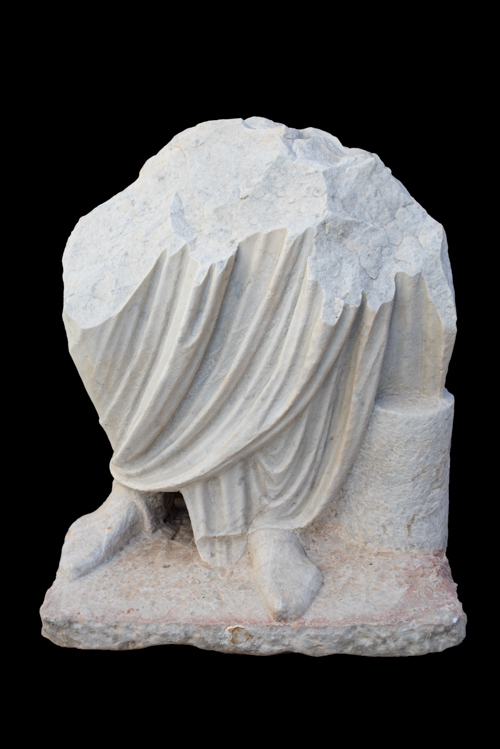Fragment of togate statue (1)
Category
Domus Romana GroupAbout This Artefact
I.D. no: 15883
Dimensions: Max. H. 80 cm; W. ?? [measurements need checking]
Material: Fine-grain white marble.[1]
Provenance: The 1881 excavations of the Roman Domus in Rabat, Malta.
Current location: National Museum of Archaeology.
Condition: Only the lower part of the statue survives, from the knee down. Affected by several break surfaces at the knee level. Several small chippings, mainly on the flat base.
Description: The togate figure rested on the left leg and flexed the knee of the right leg from behind. Both feet, however, rest entirely on the ground. A plain cylindrical scrinium serves as a support on the side of the left foot. The surface of both the scrinium and the base is roughened by frequent chisel blows, in contrast with the drapery which is rendered with monotonously repetitive curving folds. The absence of any thongs on the shoes suggest that the foot wear belongs to the calceus equester typology.[2] The back of the statue is totally plain.
Discussion: The type of statue to which this fragment belonged is that which Goethert found to be particularly common in the reign of Emperor Tiberius.[3] There are several examples that can be cited in which the pattern of the folds of the toga repeat constantly the same scheme, such as the torso from Ostia,[4] a similar fragment from Syracuse,[5] and three other statues from Mérida, in Spain.[6] These parallels suggest a date in the first half of the first century AD while the context of discovery narrows the time bracket even further to the Claudian reign, though one should keep in mind that these togate torso were mass-produced and could be used, even reused, over the reign of various emperors.
The type of shoes suggests that the person depicted belonged not to the imperial house but to a magisterial status. This and the following two fragments of the same typology (I.D. nos 15884 & 15885), therefore, could have represented members of the domus household or local magistrates.
The workmanship of the fragment is of mediocre quality and stereotyped, lacking all sense of the pictorial. The lack of ability or interest in the finish – the scrinium is left without any decoration – confirms the conventional, even mass-produced, character of the statue.
Bibliography: Caruana 1881: 7. Ashby 1915: 40-41. Zammit 1930: 22: “scribe”. Bonanno 1971: 164-66. Bonanno 1992: 23, pl. 30; Goette 1990: 123-24 Ba 213.214 (Claudian).
[1] Carrara according to Lazzarini (personal communication 24.02.04).
[2] Goette 1988: 451, 464.
[3] Goethert 1939: 186-88.
[4] Calza 1964: 102, no. 169, pl 100.
[5] Bonacasa 1964: 150, no 213, pl. 88,4.
[6] García y Bellido 1949: 187-88, nos 212-24, pl. 157.

